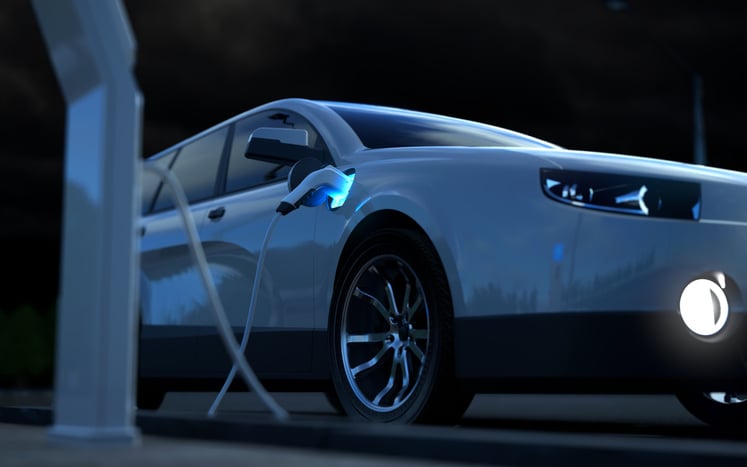Thermal management in ev's: Detection and mitigation

By 2030, more than half of all new vehicle sales worldwide are expected to be electric. The shift is no longer theoretical — it’s underway, and accelerating fast.
Electric vehicles (EVs) and hybrid electric vehicles (HEVs) are set to surpass internal combustion models within the decade. With rising consumer demand and tightening regulations, most major automakers are moving toward lithium-ion battery packs for everything from passenger cars to city buses.
As production scales, thermal management has become a critical part of the conversation. Lithium-ion batteries offer the high energy density needed to power modern EVs, but that same density makes them more vulnerable when things go wrong. Under stress, a single failing cell can set off a chain reaction, making early detection and prevention one of the most important factors in battery design.
Long viewed as one of the toughest engineering challenges in EV safety, thermal management now sits at the center of what makes these vehicles ready for the road.
What Does a Thermal Management Look Like in an EV?
Though rare, thermal events in a lithium-ion battery can result in damage to the vehicle battery pack and the vehicle itself, as well as serious injury to any occupants.
Often triggered by a short circuit, overcharging, or other cell stress, a thermal events occurs when a lithium-ion battery becomes overheated. The excess heat triggers a chain reaction in the cell that generates gas. If not mitigated, can spread to the rest of the battery pack, causing other cells to overheat and decompose. As the event takes hold and battery cells break down, the event causes the release of flammable gases, such as:
- Hydrogen
- Volatile hydrocarbons
- Carbon monoxide
Other hazardous gases released during a thermal events include:
- Hydrogen Fluoride
- Carbon dioxide
- Dimethyl carbonate
- Acetonitrile
Once a thermal event begins, it’s difficult to stop. Its chain reaction can cascade through a battery pack, often causing smoke and flames. With quick intervention, it’s possible to limit a thermal event’s impact on a battery pack, as well as the rest of a vehicle. While many materials used in the pack are designed to reduce the risk of fire propagation, once a cell vents gas, a hazardous condition exists within the battery pack that must be identified and dealt with to prevent the risk of fire.
Managing Thermal Event Mangement in ev's
Thermal management in EVs and HEVs requires a three-pronged approach:
- Mitigating the events from starting in the first place
- Identifying if or when a thermal event is occurring within a cell
- Stopping the event from spreading to other parts of the battery pack
In any case, stopping a battery thermal event happens through two methods: active and passive thermal management systems.
Active Thermal Management
Active thermal management relies on cooling systems that keep a battery pack at an optimal temperature.
When the cells start to heat up during charge or discharge, an active thermal management system extracts heat from the cells using air or cooling plates with conventional automotive coolants or even refrigerants to bring temperatures back down. It’s not unlike how a radiator keeps temperatures in check inside an internal combustion engine.
Passive Thermal Management
Passive thermal management systems are more focused on the later stages of preventing thermal events. Rather than keeping an affected cell cool, a passive system, such as a heat shield or insulation, blocks excessive heat from passing from an individual cell to the rest of a battery pack and continuing the chain reaction.
The idea behind passive thermal management systems is similar to compartmentalization as a form of fire protection in buildings. By containing a fire to an area, it doesn’t spread to other parts of the structure.
Sensor Technology for thermal Event Management
Like any other vehicle, keeping an EV or HEV running at peak performance involves constant monitoring of its systems — that’s why electric cars, trucks, and buses have sensors and electronic controls that constantly monitor the battery condition and automatically provide appropriate cooling or heating as needed.
 Regardless of an EV’s thermal management system for its battery pack, sensors play a critical role in stopping a thermal event from spreading.
Regardless of an EV’s thermal management system for its battery pack, sensors play a critical role in stopping a thermal event from spreading.
In the early days of lithium-ion battery pack thermal management, sensors measured heat — the immediate, obvious sign of a thermal battery event. Now, sensor technology is taking a much different, and more scientific, approach toward thermal management, by monitoring for the gas release of a venting cell, the precursor to thermal events
Hydrocarbon sensors and air pressure sensors have been trialed to detect thermal events, but they aren’t accurate or robust means for thermal event detection. Other materials inside a battery pack can interfere with a chemical sensor’s performance, skewing their readings and ultimately causing the device to fail.
Air pressure sensors are vulnerable to variations in the battery pack’s venting system as well as altitude and temperature changes in the vehicle.
Physics-based gas sensors using technologies such as thermal conductivity or infrared spectroscopy, on the other hand, rely on fundamental physics principles to detect the signs of thermal events and allow for continuous monitoring after a battery thermal event begins. Using light-based and thermal conductivity technologies, gas sensors measure for CO2 and hydrogen — the first gases vented by a battery cell during a thermal event.
Unlike hydrocarbon and pressure sensors, these sensors are not affected by their environment in ways that degrade their performance over time, and their readings only measure the gases released at the beginning stage of a thermal event.
These measurements are critical in providing the earliest possible warning to the battery control system, thereby reducing the risk that the thermal event will spread to other cells in the battery pack, and providing a best-case scenario for safety and response.
Q: Are there industry standards or regulations around thermal Event management?A: Yes. Standards like SAE J2464, UL 2580, and UNECE R100 require EV batteries to undergo safety testing that includes thermal event scenarios. These regulations don't mandate specific technologies, but they do require that thermal events be contained and managed to limit risk to the vehicle and occupants. |
Q: How does thermal Event risk change as EV batteries age?A: Aging batteries can become more vulnerable due to chemical breakdown and increased internal resistance. While thermal events remains rare, older cells may respond less predictably under stress, which is why battery management systems track wear and adjust charging behavior over time. |
Q: What roles does battery pack design play in stopping thermal events from spreading?A: Battery design helps limit how thermal events moves between cells. Features like insulation, venting paths, spacing, and cooling systems work together to isolate failures, slow heat transfer, and give the system time to respond before a small event turns into something larger. |
Explore Sensor Technology For Optimized EV/HEV Performance
Visit our EV/HEV Sensor Resource Hub:
Thermal Event Management in next-gen ev's
As EVs and HEVs continue to replace combustion-powered vehicles, battery safety has become a central focus. Preventing failure is a technical challenge, but it’s also a matter of earning trust as the industry moves toward electric. That trust depends on early warnings, fast responses, and designs that account for the unexpected.
Thermal event management supports that effort. It makes electric vehicles safer and sets a higher standard for the industry, not just for today’s vehicles, but for what comes next.
Take a Deeper Dive Into Thermal Event Management
Sign up for our on-demand webinar, Robust Early Detection of Electrolyte Leakage and Cell Thermal Event






